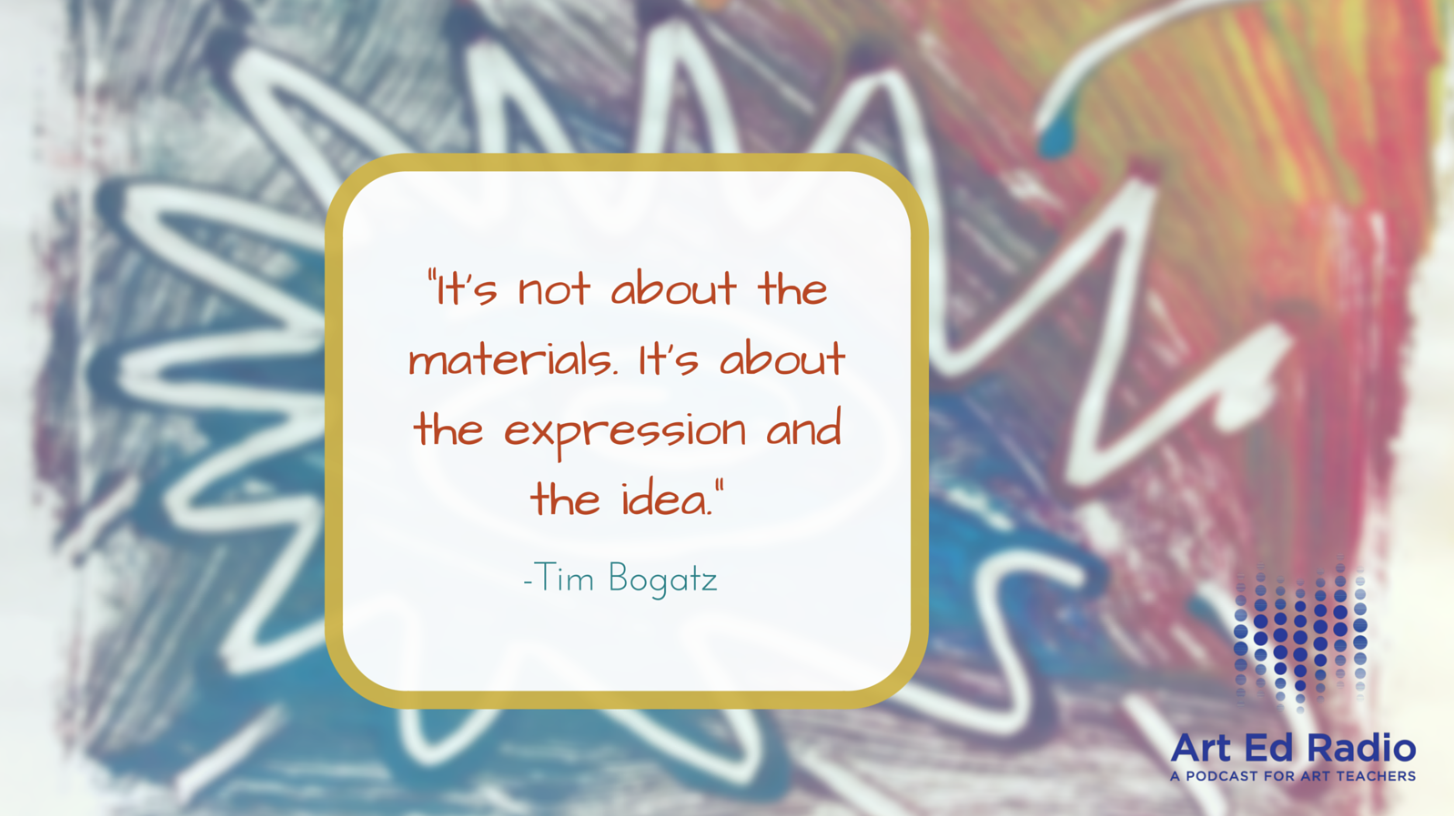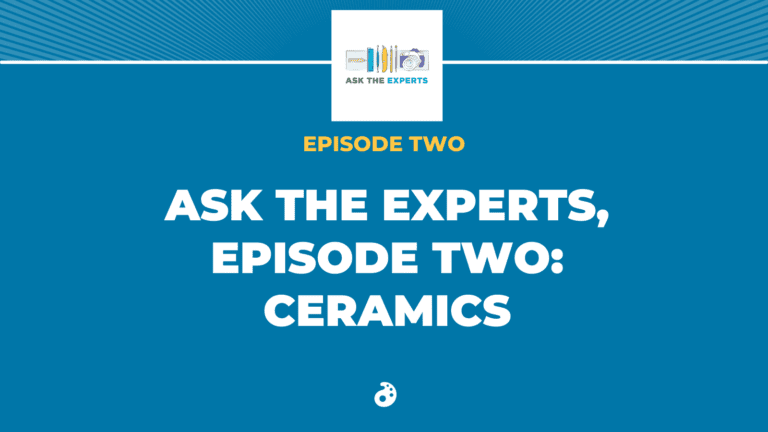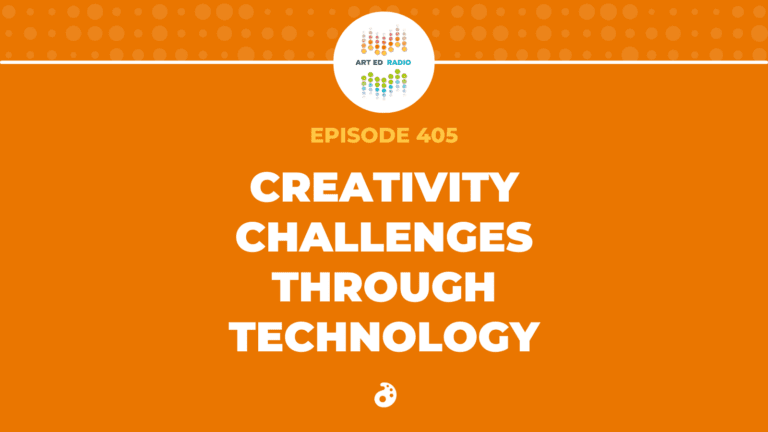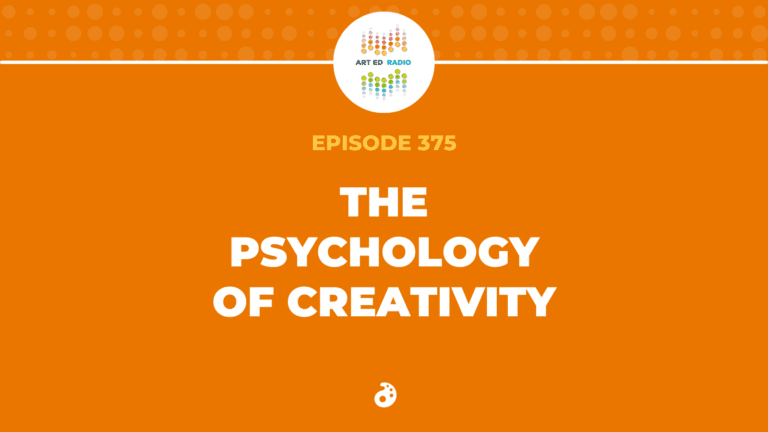“Craft” is a contentious word in many art rooms and art programs. Craftsmanship is an important part of what art teachers do, but “craft” is also synonymous with googly eyes and pom-poms. Many parents and members of the community have a negative association with “crafts”, so how do we accurately depict what we do while also letting it be known that craftsmanship is important? Tim comes on the show, and the guys talk about the difference between art and craft (8:30), Andrew’s problem with craft-based curricula (10:30), and how to turn crafty materials into a viable form of creative expression (16:00). Full episode transcript below.
Resources and Links:
- A great article (and discussion) about art vs. craft
- A good 5 minute TED lesson that explains the difference
- Moving beyond Art vs. Craft
- Why Preschool crafts are a waste of time

Transcript
Welcome to Art Ed Radio, the podcast for Art Teachers. This show is produced by The Art of Education, and I’m your Host, Andrew McCormick. I think this may end up being one of those divisive episodes where Tim and I kind of split our loyal listeners. We’re talking today about Crafts. Love them, hate them, misunderstand them. It seems like every Art Teacher out there has a stance on crafts, so given that we have so many different takes on this subject, I think we can easily say that we have a problem with Craft. Let’s look at what I consider to be the biggest point of contention, that there are just too many murky definitions of the word crafts. In a second, I’m going to bring on my good friend, Tim Bogatz, to help me unpack the crafts problem, but you know, I think as Art Teachers, we know the difference between crafts, craftsmanship, and crafty.
The problem is, and I’ve personally found this to be true, that our constituents, administrators, community members, fellow teachers, parents, students, they’ve all lumped all three of these ideas into that last word, crafty. This is the world of pipe cleaners, googly eyes, Popsicle sticks, all that stuff. Now there’s nothing wrong with this per se, but I would argue that as Art Teachers, we can and should do more than this, and we should strive to be taken seriously. We should be in a world of fine craft and craftsmanship. A beautifully toned piece of homemade paper, that’s a beautiful craft. A hand-sewn accordion book, that’s a thing of beauty. That’s gorgeous craftsmanship. I think craftsmanship is critical in all Art forms. Whether it’s a thrown coffee cup, thrown on the wheel, to drawings and paintings. My beef, and I’d say it’s the beef of all fellow Teachers that kind of think like me, is that there are so many people out there that clump all of these things into really what is the realm of crafty?
To finally be blunt about this, my problem with an overly-crafty curriculum and crafty projects, in general, is that they’re usually pretty darn formulaic. Do this, then this, then this, and then presto, you’ve got a glittery pair of sunglasses. I mean, there’s just not enough creativity. Not enough student choice. Not enough opportunities for students to thrive, and conversely, for them to fail and learn through that failure, but I wonder if when Tim gets on, if there’s going to be a time and a place if he’ll agree with me, or maybe we can talk about this? If there’s a time and place for some of these more sort of lighthearted fun “crafty projects?” Listen, I don’t want anyone out there whose listening to this podcast to walk away and feel distraught, that their curriculum is too crafty. If you feel this way, what kind of a podcast host would I be if I didn’t offer up some solutions, right?
Let me recommend that you check out The Art of Education’s Course, Design Your Art Curriculum. Now I love teaching this class, as I know that students always walk away feeling like they’ve got plenty of new tips and tricks to take their curriculum to the next level. You’ll supplement what you’re already doing with some new, fresh ideas. Designing Your Art Curriculum is a three credit course, and it begins at the first of the month. Sign up now before summer officially gets away from you. Head on over to theartofed.com, and check out this course, and all the other great courses under the Courses tab. All right, so now let’s welcome back to the show my longtime podcast Host and Glitter Hating Grump, Tim. All right, Tim. Now when I hear the word, “Crafts,” man, I got to be honest. My skin starts to crawl a little bit. What’s going on here? Is it just a bad association for me or am I a big, fat jerk?
Tim: My skin crawls a little bit, too, when I hear, “Crafts.” Just to let you know, so-
Andrew: Okay.
Tim: I think we’re on the same page with that. I don’t know. I just have this aversion to googly eyes and glitter. I know that’s an oversimplification, but I have a tough time finding a good place for all of that kind of stuff in my Art room.
Andrew: Right. I mean, I think, what you brought up, it’s a simplified association. I mean, maybe we can get right into the bigger thing. Because like, there is good crafts out there, but I think what we need to sort of suss out is the difference between crafts, crafty, and craftsmanship.
Tim: Right.
Andrew: Now I’m going to just confess here. Two of those things, I’m actually a big fan of. I’m a fan of craftsmanship, of course.
Tim: Yeah.
Andrew: I can be a fan of crafts. It’s crafty where I think we get into, for me, kind of a danger area. Do you see these as distinct different things that just get muddy? Are they all one in the same for you?
Tim: No, they’re definitely not one in the same. I think, for a lot of people the difference between quality crafts and just regular crafty type stuff that you’re taking about, probably does get muddied a little bit, but I think as Teachers, we can try and delineate those sorts of things. Craftsmanship, obviously, like you said, I’m a huge fan. That takes high priority in my classroom. I really want my kids working toward a good level of craftsmanship in everything that they do.
I think, crafts themselves, although I’m not a big fan of, those definitely have a place in my room, and those are definitely worth talking about, and I love talking to my kids about the difference between Art and craft. Because that leads to a lot of great discussion, but at the same time, when kids are bringing in their scrapbooks and showing those to me, “What do you think of my Art project?” I hate to say, “That’s not an Art project,” but that’s worth talking about. Like you said, you don’t want to be a jerk about it, but I think it’s important to teach kids the differences, and like you said, delineate the differences between all three of those things.
Andrew: Well, so do you even think, to further delineate this, do you think there’s a difference between high craft and low craft? For example, we’ve talked on some episodes about going to an Arts Festival, and you’ll see some really awesome … Let’s talk about wood turning, for example. Someone who wood turns-
Tim: Yeah.
Andrew: A bowl on a lathe. That can be really beautiful.
Tim: Yes.
Andrew: I would consider that to be high craft, and then you think about friendship bracelets. I mean, everyone likes a good friendship bracelet, but is that low craft, and is it okay to do that, kind of high and low?
Tim: Yeah, I don’t know. That’s a really good question, because at some point you just appreciate anyone who is creating, right?
Andrew: Sure.
Tim: Whether it’s high craft or low craft, but then who are we to judge that and say, “Oh, this is so much more worthwhile than this?” I think that’s a good discussion to have. Again, like I said, I enjoy talking about those things with my kids. For me, a big part of it is the creativity that goes into it. I think, there’s definitely a different skill level between wood turning and friendship bracelets, for example.
Andrew: Right.
Tim: Again, is it my place to pass judgment on one of those being better than the other?
Andrew: Well, it’s an interesting thing to bring up, because it’s like as a Teacher of students, we could say, “Yeah, it is our place to kind of pass judgment,” or at least give expertise, and say, “Well, this might have more value in society or be better because of maybe time spent or how long it took this person to get good at this thing.” Whereas this, you watch a YouTube video, and ten minutes later, you’ve made a thing. I want to circle back to something you said that you talk about in your classroom, because I think this brings up that idea. You said, “You talk to your students all the time about the difference between crafts,” and again, we’re talking about the good kind, not the googly eyes and the glitter and the Popsicle sticks, and Art. What do you think is the difference between craft and Art?
Tim: For me, a big part of it is creativity. When you are creating Art, possibilities are almost limitless. There are so many incredible things you can do, so many choices of media, and so many ways to express yourself. That’s really kind of where the appreciation comes from, is the student voice or the artist voice, and what they’re expressing and what they’re showing. Then when you move to the world of pom poms and googly eyes, I don’t know how many times we’re going to say, “Googly eyes,” in this episode, but when you move to that craft, you are so limited by what you can do. There are only so many things you can make with Popsicle sticks. I think that while working within limitations can sometimes be good, I think that those materials are so limiting that it’s really difficult to have much expression or much artistic voice. If you value hearing what the artist is thinking or learning what the artist to express, then it’s really hard to do that with those “crafty materials.”
Andrew: Yeah, I’d agree with that. I got to confess here. The reason I’m super interested in this topic is, when I actually started teaching in Cedar Falls, one of my most popular classes that I inherited was Crafts … I think it, yeah … It was called Crafts. That was it. I would get so many phone calls from parents wondering, “What is this class?” Because I think they associated it with, “The Crafty,” the glitter and-
Tim: Right.
Andrew: Pom poms and Popsicle sticks. To them, having their son or daughter take this not so serious class as an eighth or ninth grader, they’re like, “What’s up with this?” I had to kind of walk them back and say, “No. It’s just like a normal Art class.” One of the … The curriculum that I inherited wasn’t great, and I think one of the things that I didn’t like about it was … And I’m probably going to really upset Cassie Stevens here and her legion of adoring fans. It was very heavy on the Fiber Arts curriculum.
Tim: Right.
Andrew: One of my beefs with Fiber Arts curriculum is once you’ve learned the technique, I felt like the creativity choices were, “What color do I want to make this in?”
Tim: Right, right.
Andrew: Because the technique … Okay, we learned the technique, and then the creativity is, once you made the choice, then it’s just a matter of getting this done over the next three and four days. Now I know I’m going to get so much hate mail here, but I do think once the choice has been made and it’s just work, and it’s 90% is just repetitive work. That, to me, is the definition of what craft is.
Tim: Yeah.
Andrew: There’s a little bit less creative choices along the way. Now, to be honest, my students love stuff like that. They love making pop tab bracelets with ribbon, because it’s kind of easy, and you’re kind of on autopilot, but that’s where I think you’ve talked about that’s where the limitations are. I want to bring this back to a question because I kind of went off on a rant here-
Tim: Okay, actually. I’m going to interrupt you, because I want to ask a question of you, or two questions personally.
Andrew: Oh, okay, okay.
Tim: Okay, so number one. How do you take that crafty curriculum and sculpt it into more of an artistic curriculum or more of what you want to teach? Then secondly, with your pop tab bracelets and all that stuff, don’t you think that your kids should be just making that stuff outside of class? Can’t they learn it in your class really quick, and then do the work somewhere else?
Andrew: Yeah, so I’ll answer the second one, because that’s probably the easier. Yes. To me, it’s like, “Oh, I want to make a friendship bracelet, I want to make a pop tab bracelet, I want to make an accordion book,” and that’s great. Fine. Quick demo, quick links to some YouTube things, go do it on your own-
Tim: Yeah.
Andrew: That’s fine. That’s the sort of stuff that I could kind of pawn off on like, “Make it on your own. Show it to me later. Great. Awesome,” but I wanted to spend more of my time back to my curriculum on stuff that was maybe a little bit more filled with student choices and creativity.
Tim: Yeah.
Andrew: What I did was I said, “Okay, what am I comfortable with teaching that I think lends itself to a more step by step technique, got to do it right, or it’s going to fall apart-sort of way.” That’s how I kind of rationalized, “Okay, this is super dependent on craftsmanship and doing it kind of of “The Right Way.”
Tim: Yeah.
Andrew: Then the subject matter and the idea is up to them. I told my students after the first year, which was kind of like a triage of what they wanted to do.
Tim: Yeah.
Andrew: What they’ve done in the past, and I mean, they were making like latch hook rugs of Snoopy. I was just like, “Oh, my God.” After that first year, I said, “Okay, it’s going to be primarily printmaking and ceramics.” Because I do feel with print making and ceramics, there’s a lot of technique and processes and step by step, and if you don’t do it right, it’s either going to blow up or turn out wrong. I said, “There’s not a lot of drawing. There’s not a lot of painting, but it’s really focused on printmaking and ceramics.” I feel like it became actually a really, really viable class after that first year or so when we kind of cleared the system a little bit.
Tim: Yeah, yeah, that’s cool.
Andrew: I mean, I’m sure there’s other Teachers out there in kind of a similar boat where they’re like, “Oh, my God. I’ve inherited this class. It’s 80% scrapbooking and 20% weaving. That’s not really my thing.” There are ways that you can slowly over time morph it into something that fits what you got to do more. All right. I want to ask this question. We’re both going to come of as like grumpy curmudgeons who hate glitter and googly eyes.
Tim: Wow, I mean, I have a long track record of that sort of opinion, but-
Andrew: Yeah, but I got to say, on your Instagram feed for your school, there was like this awesome paining of I think it was a banana with googly eyes, right?
Tim: Yeah, yeah.
Andrew: I mean, there is a time and place for googly eyes, so what do you think that is? I mean, is there a balance that we, as Art Teachers, can strike between Fine Art, Craft, and even crafty stuff?
Tim: Yeah, I really think there is, and as much as I may come across as that curmudgeon, as you like to call me.
Andrew: Right.
Tim: I really want my kids to enjoy Art, and they’re not going to enjoy creating, and they’re not going to enjoy making if I’m constantly over their shoulder going, “Oh, no that’s not what we’re doing.” “Oh, no. You can’t do this.” “Oh, no. You can’t do this.” I think you need to be flexible, especially if that’s something that you want your kids to do, or if they want to do that, I should say, and if they are really into trying something like that, you need to let them experiment. You can’t constantly be saying, “No, that’s not good enough. No that’s not the right type of Art.” What you can do is just present your best ideas, your best lessons, and see where they take them.
Maybe they do need to make a sculpture with Popsicle sticks every once in a while, but at the same time, that’s not the only thing that they’re going to be doing. I think, if they try that once or twice, they’re probably going to get it out of their system, and they’re going to move onto that more creative work that we’re looking for. I don’t think you need to constantly X out things and say, “No. We can’t do that.” There may be a place to let kids sort of bring their own interests, and let them try that, but then it’s our job, as Teachers, to help them move beyond and look for those more creative projects, those more expressive ideas that they may want to be doing.
Andrew: Right, and it isn’t just the googly eye manufacturers of the world are going to feel like we’re ganging up on them, because it isn’t just about the materials. Right?
Tim: Right.
Andrew: There’s plenty of Artists out there who are working with embroidery and beads and googly eyes and glitter paint, who are actually making really imaginative, and stuff that kind of turns our expectations of those every day Hobby Lobby materials on its head. I think that’s … We could get our students to think that way. Anyone could build a picture frame with Popsicle sticks and sea shells, but why aren’t you building a horse busting out of a flaming building out of Popsicle sticks? That would be a much more interesting sort of take on this every day-
Tim: Exactly, as kind of a flip side to that, there’s so many Oil Painters and Water Colorists that are just complete hacks, and doing these cliché, trite things, and so it’s very much not about the materials. It’s very much about the expression and about the idea.
Andrew: Okay, so that bring me up to kind of my summation. I think it’s this. It’s not the materials, and it’s not necessarily the word itself. “Oh, you know, run and hide from the word Crafty or Craft.” It’s how teachers and students are interpreting that stuff. I don’t think it’s the material itself. It’s how Teachers run their curriculum. When you say, “First you do this, then you do this, then you do this. Then you slap some googly eyes on it and sprinkle it with glitter, and you got a turkey.” That’s not really a good curriculum. That is what I would call a Crafty Curriculum. I think that our students and our parents and our communities expect a little more out of us, because they can do that at summer camp and Boy Scouts and Girl Scouts and 4H, and stuff.
Tim: Exactly.
Andrew: Would you kind of agree with that stance or am I being a jerk?
Tim: Yeah, no. I think that’s good. I think, as Teachers, we need to fight for that creativity and fight for that expression. Like I said, it goes back to the question I asked you. Can’t our kids be doing that kind of stuff outside of class? We need in our classrooms to be giving our kids opportunities that they don’t have anywhere else. Okay. We need to offer them materials that they can’t afford or they’re not going to go buy, and we need to offer them projects that they wouldn’t find or wouldn’t see anywhere else. Again, the materials sometimes are irrelevant, sometimes are not, but the idea is that we need to offer them those outlets for creative expression that they’re not going to find other places.
Andrew: All right. Well said, you big, curmudgeony jerk, you. I think, we need to make like dual mics so we can drop them when we’re done with our episodes. Yours can be all glittery and mine can be all googly-eyed.
Tim: This sounds like a terrible idea.
Andrew: Yeah, terrible idea. Thanks, Tim. Thanks for coming on, man.
Tim: Thanks, Andrew.
Andrew: All right. Thanks to Tim for coming on and convincing me that I am not too big of a Craft Hating Jerk. Whether you subscribe to the camp that sees a big difference between Art and crafts, or the camp that loves craftsmanship, but kind of hates all the crafty-craft out there, or even the camp that can get on board with all those definitions, but regrets the fact that so many in society see it all just lumped together into “Crafty,” I think that this episode has some big takeaways regardless of what camp you fall into.
Number one. Define crafts for you. Where are you at on the spectrum? Okay. Number two. Think about the choices that you are making in regards to crafts, craftsmanship, and crafty-craft that’s out there, and then think about what your students are gaining or losing from your take on this issue? Then finally, think about some ways that you can be more inclusive of the other side of the argument here. You know, maybe ditch a few crafty-craft projects that you’ve been doing. You know, you can go ahead and skip buying all those macrame supplies that you love to buy. Conversely, you know, go ahead and do a fun little crafty project if you think that your students are going to love it and get a lot out of it. You know, call it what it is. It’s a reprieve from your classes’ routine and norms that can be very fun and whimsical, or serious, depending on how you structure your take on craft, but be careful. Do not go too head over heels for this crafty stuff, or before you know it, you’re going to be having your students be dazzling tie-dyed punch pillows.
Art Ed Radio is developed, produced, and supported by the Art of Education, with Audio Engineering by Michael Crocker. You know, if you’ve been enjoying what Tim and I have been doing with this show, do yourself a favor, and head on over to artedradio.com, and click on the I’m A Fan button, and you’ll be added to our list to receive advanced reminders about past episodes, upcoming guests, and updates on all things Art Ed Radio. New episodes are released every Tuesday, and additional content can be found under the Podcast tab on theartofed.com. Thanks for listening.
Magazine articles and podcasts are opinions of professional education contributors and do not necessarily represent the position of the Art of Education University (AOEU) or its academic offerings. Contributors use terms in the way they are most often talked about in the scope of their educational experiences.



